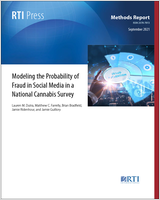From: Modeling the Probability of Fraud in Social Media in a National Cannabis Survey

Modeling the Probability of Fraud in Social Media in a National Cannabis Survey [Internet].
Dutra LM, Farrelly MC, Bradfield B, et al.
Research Triangle Park (NC): RTI Press; 2021 Sep.
© 2021 Research Triangle Institute. All rights reserved.
This work is distributed under the terms of a Creative Commons Attribution-NonCommercial-NoDerivatives 4.0 license (CC BY-NC-ND), a copy of which is available at https://creativecommons.org/licenses/by-nc-nd/4.0
NCBI Bookshelf. A service of the National Library of Medicine, National Institutes of Health.